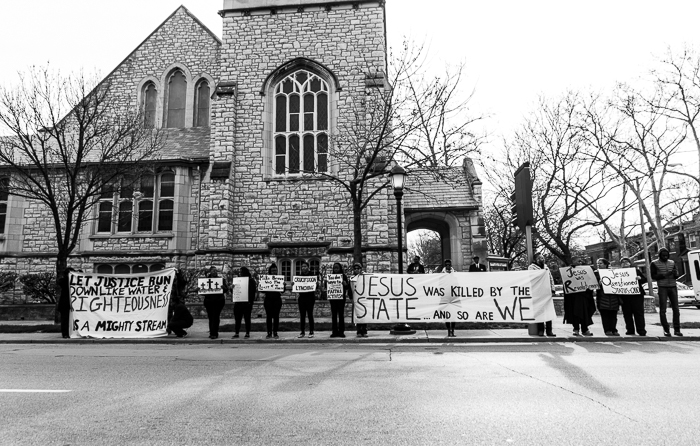Protest. What comes to mind when you think about a protest? What’s the vibe? Would the silent protests common among monks come to mind? What about the hunger strikes in prison? Probably not, because the media doesn’t like to hype and loop that kind of protest.
The portrayal of Ferguson protests has been narrow. And in many ways, the protest actions have not utilized the multitude of forms protest can take.
Millennial Activists United has worked to change the narrow portrayal of protest in St. Louis. From their die-in in Lambert airport to their creative dramatic vignettes at #BlackBrunch, MAU is making sure we “stay woke” and continue to acknowledge that deleterious effects of police violence on Black lives.
Let’s revisit the definition of protest: an expression of bearing witness on behalf of an express cause by words or actions with regard to particular events, policies, or situations. Protests can take many forms, from individual statements to mass demonstrations
When you get bad service at that restaurant and commit to never return, you are protesting. When you sign that online petition, you are protesting. We do it all the time. However, protesting in St. Louis post-Ferguson has often meant confrontation and tear gas. So I get why some people don’t understand the concept of protesting outside of this frame.
MAU has known that clever, thoughtful, and strategic actions are needed for #BlackLivesMatter to continue to grow as a movement. On Easter Sunday, they brought the protest to the #BlackChurch. It was a SILENT action where protesters hummed “Wade in the Water” when approached or engaged. Signs and banners read, “Jesus questioned the status quo,” “Let justice run down like water and righteousness as a mighty stream,” and “Jesus was revolutionary.” The most “agitating” posters read, “Mike Brown was the least of these,” “You don’t have to choose between faith and activism” and “crucifixion = lynching.”
They have outlined their reasoning, but I would like to add a few thoughts.
The protest was aimed at the Black church as an institution. And what better time to bring a plea for community and connection to the Black church than Easter (i.e. record attendance)? As a whole, the Black church could do better at connecting the work of #BlackLivesMatter to the radical-servant-to-the-least-of-these named Jesus. There are a number of clergy doing amazing work, but we must not conflate the individual with the institution. Challenging an institution does not mean that all individuals within said institution are in lock step. So MAU protesting the church does not mean all pastors and parishioners are “bad.” It is simply a call to reflect on if we are truly using all in our sphere of influence to publically support or effect change in the status quo regarding law enforcements’ treatment of Black lives. Rather than be offended that a particular church was targeted, it might be best to consider it an opportunity. One church, New Cote Brilliante, was welcoming and the pastor came out to express his support. Another called the police—even after one deacon explicitly agreed with each sign as he walked down the line of protestors. Another used their group of approximately 15 male deacons to attempt to intimidate and physically block protesters. Mind you this was in response to silence and the intermittent humming of a Negro spiritual.
The church missed an opportunity to be welcoming and expansive rather than intimidating and narrow. It is unfortunate and not indicative of all within the Church as evidenced by the welcoming spirit of some (even several parishioners at the church where the deacons physically blocked protesters were supportive). They failed to see that the protest was not about calling them out in an adversarial way but calling them to community and connection in a loving way. We all have work to do. I have not done all I could do, and the institutions I am a part of still fall short. Rather than be offended and defensive when I am forced to see these shortcomings, I attempt to maintain and spirit of openness—to the fact that I can’t always see myself and that others might have something to offer from their vantage point.
I’m reminded of when Saint Louis University was occupied in the fall. Many were outraged, yet President Pestello saw it as an opportunity to be reflective and model the Jesuit spirit. He’s been given kudos within and outside of Jesuit institutions. Let’s be honest, Pestello could have let his ego lead, had protestors kicked off campus and defended that SLU has a record of working in the community. Instead he chose to engage the protestors and was willing to ask how SLU could improve. I recently spoke on a panel about “living the mission” at SLU. An alum stood up and asked, “Why us?!” My response was that while I do not know, I choose to see it as a compliment rather than solely an indictment. And I’m grateful we have the leadership to navigate such an opportunity.
How would you feel if a protest came to your front door? Would you be able to hear the message and potentially stand in solidarity, or would you be so lost in your defensiveness and indignation that you would meet their message with anger?
MAU continues to push us outside of our comfort zone, and truthfully, that is the only place real change happens.

